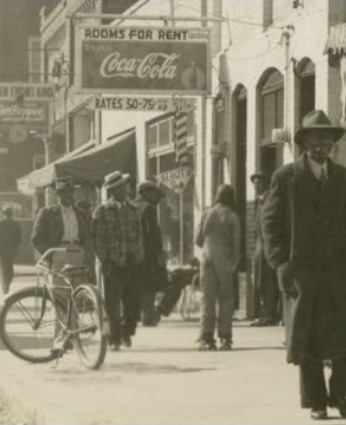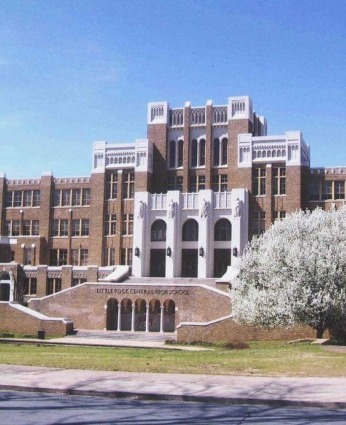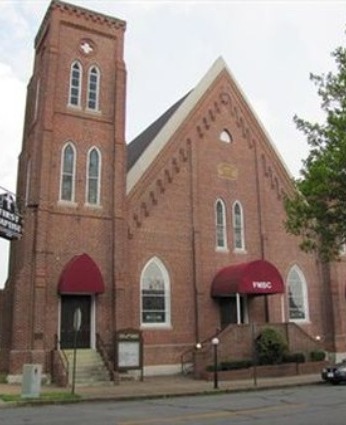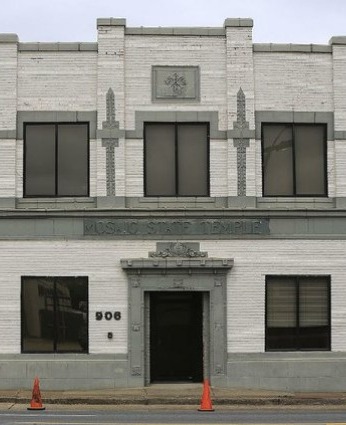
West Ninth Street District
Ninth Street was a city within a city. African Americans lived parallel to white society and didn’t need to frequent white businesses because they had everything they needed on 9th Street. Some of the businesses housed on this street included confectioners, delivery services, pharmacies/drug stores, grocery stores, jewelers, hotels, taxi companies, mortuaries, theaters, barber and beauty shops, newspaper publication offices, auto repair shops, tailoring-cleaning and pressing shops, service stations, restaurants, print shops, and athletic centers. There were jobs to be had and services to be rendered. Segregation resulted in racial solidarity and a separate black economy, which benefited Arkansas’s black population tremendously. This business center was vibrant, bustling, and complete; and it offered a sense of security to the black population.
The Mosaic Templars’ economic self-help principles prompted the development of a black insurance company, health and medical facilities and training a number of black physicians, dentists, and lawyers. The emergence of black professionals in this self-contained community created opportunities and short-term gain for individuals in the black community. However, a closed market in which black business people did not have to fully compete with whites provided economic gain for many but lacked sustained growth. Segregation and racial prejudice caused limited capital and access to goods. It was often impossible to compete with larger white-owned stores and over-all economic growth was negatively affected.
Information courtesy of the Mosaic Templars Cultural Society

Little Rock Central High School National Historic Site
On the morning of September 23, 1957, nine African-American teenagers held the line against an angry mob protesting integration in front of Little Rock's Central High School. As the students met their new classmates for the first time inside the school, outside violence escalated and the Little Rock police removed the Nine from the school for their safety. The next day, President Dwight D. Eisenhower ordered the U.S. Army's 101st Airborne Division into Little Rock to escort the nine students into the school. One of the nine later remembered, “After three full days inside Central, I knew that integration is a much bigger word than I thought.”
This event, broadcast across the nation and world, was the site of the first important test for the implementation of the U.S. Supreme Court's historic Brown v. Board of Education of Topeka decision of 1954. Arkansas became the epitome of state resistance when the governor, Orval Faubus, directly questioned the authority of the federal court system and the validity of desegregation. The crisis at Little Rock's Central High School forced the nation to resolve to enforce African-American civil rights in the face of massive southern defiance during the years following the Brown decision. Today, Little Rock Central High School is an active school operated by the Little Rock School District.

Historic First Missionary Baptist Church
On Sunday, January 13, 2019, The Arkansas Martin Luther King, Jr. Commission kicked off the King Week with the dedication of the Martin Luther King, Jr. Memorial Parsonage. In 1963, months after his famous “I Have A Dream” speech, Dr. Martin Luther King, Jr. preached the sermon at First Missionary Baptist Church’s 118th Church Anniversary just four months before the March on Washington and his famous “I Have a Dream” speech. King gave the church’s 118th-anniversary sermon. The podium and bible that Dr. King used that day are still on display in the church’s sanctuary. First Missionary Baptist Church in Little Rock, Arkansas is the oldest black church in the state. It was founded by Reverend Wilson Brown, a self-taught slave minister, in 1845. Brown had attended the predominantly white church Missionary Baptist in Little Rock but felt led by God to build a house of worship for slave and free blacks in the area. In April 1845, Brown, his owner, Major Fields, and an unidentified Baptist minister established what they called the First Negro Baptist Church. There was no building for a number of years so the congregants, after gathering in various locations, began to meet on May 2, 1847 at a regular basis at a brush arbor at the corner of what is now Tenth and Spring Streets in Little Rock. The brush arbor remained the meeting site until the church’s first permanent building was constructed at that site in 1882. As the church congregation grew, a new building was constructed on the corner of Seventh and Gaines, the church’s current location. In 1983 First Missionary Baptist Church was added to the National Register of Historic Places. First Missionary Baptist Church served as a social and political center as well as a site of worship. The church’s fifth pastor, Reverend Ronald S. Smith, became very active in the civil rights movement. In the wake of the 1954 U.S. Supreme Court decision in Brown v. Board of Education, Smith led a group of local ministers in calling for an end to segregation in the public schools and public accommodations. Those ministers met with Arkansas Governor Orval Faubus on February 23, 1956 a little over a year before he became internationally famous for his efforts to prevent the desegregation of Little Rock’s Central High School. Faubus did not change his position on racial segregation after meeting with the ministers but on February 18, 1957 in the midst of the Little Rock desegregation crisis, he arranged for Reverend Smith to become the first African American to speak before the Arkansas State Senate’s Constitutional Amendment Committee. There Smith called on the state government to end segregation.

Mosaic State Temple
The National Temple Department was formed in 1908 to provide for the construction of the Mosaic Templars of America Headquarters on the southwest corner of Broadway and Ninth streets in Little Rock. It was reported in History of the Mosaic Templars of America, “Up to this time no other Negro organization had specially provided for itself a headquarters and domiciled in such an imposing structure as was authorized and erected. The Mosaic Templars of America were the first to make this venture.”44 The building was completed in 1911 and it soon came to epitomize the empowerment of the African-American race as an example of what could be accomplished through the black initiative. The organization was founded before Booker T. Washington’s self-help philosophy achieved national attention but it signified the same tenets. With the encouragement of Bush, Washington traveled to Little Rock in 1905 to speak on his philosophy. Bush again extended an invitation to Washington in 1911 to hold the annual meeting of the National Negro Business League. His final visit in 1913 brought him again to Little Rock for the dedication of the Mosaic Templars Headquarters attended by an audience of 2,000 blacks and 100 whites in the auditorium. In that year Washington also became a policyholder.45 The red brick Templars Headquarters was said to have been constructed on the site of a small wooden house where Bush and Keatts held their first meeting to plan the formation of the organization in 1882. The building stretched for half a block and rose three stories exhibiting Neo-Classical and Art Nouveau influences. Storefronts occupied the first floor, which were rented by the Templars to supplement upkeep and construction funds. Officers of the Templars Order had offices on the second floor, and the third floor held an auditorium used for Grand Lodge meetings, dances, conventions, parties, commencements and games. The Headquarters was lavishly furnished and readily conveyed the sense of pride that African-Americans were beginning to feel through the small political and social strides they were participating in at the time. Symbols such as this would come to hold great importance, as those hard-earned advances were fast disappearing. In 1918, a two-story annex was built on Broadway Street next to the headquarters. The annex’s second floor housed a thirty-bed medical facility and a training school for nurses from 1927 to 1931. Added to the Broadway Street complex in 1921 was a third building, the State Temple Building—a design of W. T. Bailey, a Memphis-based African-American architect.

The Home of Daisy Lee Gatson Bates
Daisy Lee Gatson Bates was a mentor to the Little Rock Nine, the African-American students who integrated Central High School in Little Rock in 1957. She and the Little Rock Nine gained national and international recognition for their courage and persistence during the desegregation of Central High when Governor Orval Faubus ordered members of the Arkansas National Guard to prevent the entry of black students. She and her husband, Lucious Christopher (L. C.) Bates, published the Arkansas State Press, a newspaper dealing primarily with civil rights and other issues in the black community.
The identity of Daisy Gatson’s birth parents has not been conclusively established. Before the age of seven, she was taken in as a foster child by Susie Smith and Orlee Smith, a mill worker, in Huttig (Union County), three miles from the Louisiana border. Gatson attended the segregated schools in Huttig. She and her future husband, L.C. Bates moved to Little Rock (Pulaski County) in 1941 to start the Arkansas State Press, a weekly statewide newspaper devoted to advocating civil rights for African Americans. Gatson and Bates were married on March 4, 1942, in Fordyce (Dallas County). Although she rarely wrote for the paper, Bates gradually became active in its operations and was named by her husband as city editor in 1945.
In 1952, she was elected president of the Arkansas Conference of Branches, the umbrella organization for the state NAACP. She and her husband worked closely with other members of the Little Rock branch as the national strategy of the NAACP shifted in the 1950s from advocating a position of equal funding for segregated programs to outright racial integration.
Although well known in the black community, Bates came to the attention of white Arkansans as a civil rights advocate in 1956 during the pre-trial proceedings of the federal court case, Aaron v. Cooper, which set the stage for the 1957 desegregation of Central High School. The case was filed for the purpose of enforcing the rights of black children in Little Rock to attend schools with whites in accordance with the U.S. Supreme Court’s decision in Brown v. Board of Education of Topeka, Kansas. Questioned by Leon Catlett, an attorney for the Little Rock school board, Bates refused to allow herself to be called by her first name. She told the attorney, “You addressed me several times this morning by my first name. That is something that is reserved for my intimate friends and my husband. You will refrain from calling me Daisy.” Without hesitating, Catlett shot back, “I won’t call you anything then,” to which Bates responded, “That’s fine.”
The federal courts at the time allowed the Little Rock school district to set its own pace for desegregation of its public schools, but they could not prevent Bates’s involvement with the first nine students who attended Central High School during the school year of 1957–58. On occasion, individuals attacked the Bates’ home in Little Rock, forcing them to stand guard nightly.
Her prominence as one of the few female civil rights leaders of the period was recognized by her selection as the only female to speak at the Lincoln Memorial at the March on Washington on August 28, 1963. The Home of Daisy Lee Gatson Bates is currently open for tours. To schedule a free tour contact Mrs. Harden at (501) 375-1957. The tour is free, but donations are accepted and appreciated for the upkeep of the museum and museum grounds.
